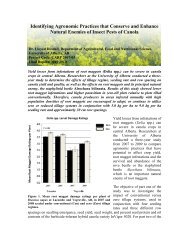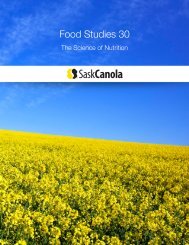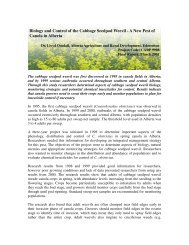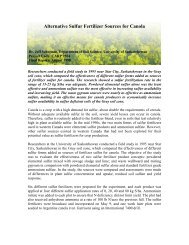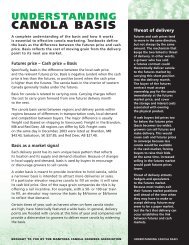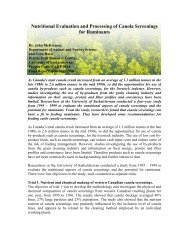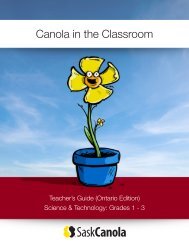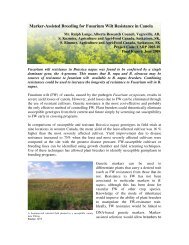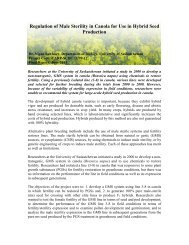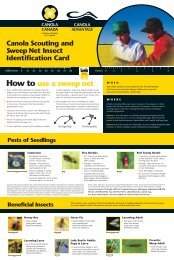Canola Digest, January 2013 - SaskCanola
Canola Digest, January 2013 - SaskCanola
Canola Digest, January 2013 - SaskCanola
Create successful ePaper yourself
Turn your PDF publications into a flip-book with our unique Google optimized e-Paper software.
LEVERAGING RESEARCH<br />
HOW DO INPUTS<br />
ADD UP?<br />
By Heidi Dancho<br />
A recent study proves the importance of<br />
optimizing fertilizer, herbicides and genetics<br />
to produce high and stable yields.<br />
hen canola is properly<br />
managed, yield improving inputs – like<br />
better genetics, fertility and herbicides,<br />
are additive; they build on each other to<br />
improve yield,” says Eric Johnson, weed<br />
biologist with Agriculture and Agri-Food<br />
Canada (AAFC) in Scott, Saskatchewan.<br />
“The result is that by combining them,<br />
we produce even higher yields,” confirms<br />
Stewart Brandt, former AAFC researcher<br />
and current research manager with<br />
the Northeast Agricultural Research<br />
Foundation in Melfort, Saskatchewan.<br />
With funding through the Prairie <strong>Canola</strong><br />
Agronomic Research Program, Johnson<br />
and Brandt led a four year canola-barley<br />
cropping sequence study to determine<br />
the effect of adding and removing inputs<br />
to both empty and full input systems.<br />
Researchers examined the impact of<br />
full and 50 percent rates of fertilizer,<br />
herbicide and seed, as well as removing<br />
fertilizer and herbicide completely,<br />
and replacing a hybrid with an open<br />
pollinated variety.<br />
“When canola is properly<br />
managed, yield improving<br />
inputs are additive;<br />
they build on each other<br />
to improve yield.”<br />
– Eric Johnson<br />
<strong>Canola</strong> input study at Scott, Saskatchewan shows the difference between the full input<br />
treatment plot (left) and empty input plot (right).<br />
In addition to illustrating how inputs<br />
build on each other to improve yield,<br />
the study demonstrated the risk of input<br />
reductions on canola yield and yield<br />
variability over time.<br />
FERTILIZER AND HERBICIDES<br />
“The study showed that there is some<br />
opportunity for perhaps reducing<br />
fertilizer or herbicides inputs for one<br />
year without a huge impact on yield,<br />
but if you continue to do this, it definitely<br />
increases your risk and greatly reduces<br />
yields,” says Johnson.<br />
For example, the study found that while<br />
cutting fertilizer rate by 50 percent had<br />
no effect on yield in year one, it resulted<br />
in yield reductions of eight, 14 and<br />
22 percent respectively in years two<br />
to four. Removing fertilizer completely<br />
resulted in yield reductions of 17, 23, 30<br />
and 38 percent respectively. Eliminating<br />
herbicides did not result in lower yields<br />
in year one, however it severely reduced<br />
yield in years two to four by 31, 60 and<br />
76 percent respectively.<br />
continued on page 14<br />
13<br />
CANOLA DIGEST JANUARY <strong>2013</strong>



